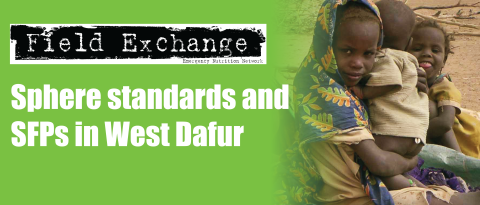Measuring household food insecurity in emergencies: WFP’s approach
Summary of published research 1
In order to contribute to efforts to standardise household food security measurement, the World Food Programme (WFP) has explored the use of a score of dietary diversity and food frequency, derived from information about households' consumption of specific food items during a designated period2. A recent article describes the findings of WFP's attempts to pilot the approach in 2004 and 2005 during Darfur emergency food security and nutrition assessments. This was the first time WFP applied the approach in an emergency needs assessment.
The approach combined three elements:
- dietary diversity, defined as the number of unique food items consumed during the previous seven days
- food consumption frequency, defined as the number of days for which each food item was consumed over the previous seven days, and
- the primary source of each food item.
In 2005, the share of food expenditures was added as a fourth element in the analysis.
In 2004, the proportion of food-insecure households was estimated in two steps:
- Households were classified into three food consumption groups (acceptable, borderline and poor) according to the diversity of the diet and consumption frequency.
- Depending on the primary source of each food item, specifically whether it was from food aid, households were further classified into three food security groups (food secure, vulnerable to becoming food insecure and food insecure). The step was aimed at estimating the sustainability of the current food consumption level through an analysis of the primary source of the foods consumed.
The methods used for the 2004 assessment were further refined in the next assessment in Darfur in 2005. The published article highlights a number of challenges and limitations that still need to be tackled using this approach that are:
Establishing common and absolute thresholds for classifying households into food consumption groups across all countries and situations. Principal component analysis and cluster analysis used in Darfur resulted in different thresholds derived from the dataset of the respective assessments. Therefore, there are limitations to the comparisons that can be made between the proportion of food insecure households in the 2005 and 2004 assessments, and between other assessments in different countries.
The period of time may not adequately account for variations according to the period when the survey is taking place, i.e. seasonality.
The approach followed in the Darfur assessments uses the consumption of food aid as a major criterion to classify household food security groups. In countries where food aid distributions are not implemented, other variables would be required to address the sustainability of the current food consumption pattern, e.g. by taking into account other sources of food such as loans or gifts as examples of unsustainable pattern. However, these variables may be context specific and again this limits the comparability of results across settings and over time.
The approach does not provide information on variations in food consumption within the household. There may be cases where the food consumption pattern is acceptable at household level but poor for some household members.
Rather than being viewed negatively, the authors argue that these and other limitations should be addressed by using these methods in a large variety of emergencies, testing different thresholds and repeating the surveys over time among the same population groups to assess seasonal variations. In addition, further analyses of the correlations between dietary diversity, food consumption frequency and food sources and other key food securityrelated indicators, such as livelihood activities, nutritional status and food availability outlook, should be conducted to estimate the capacity of this approach to assess the various dimensions of household food security.
Other desk reviews conducted for the Strengthening Emergency Needs Assessment Capacity (SENAC) project in 2005 and 2006 can be found on the SENAC website, www.wfp.org/odan/senac
1 Aiga.H and Dhur. A (2006). Measuring household food insecurity in emergencies: WFP's household food consumption approach. Humanitarian Exchange, No 36, pp 36-39, December 2006.
2 This work was undertaken within the framework of the WFP Strengthening Emergency Needs Assessment Capacity (SENAC project), with funding from DFID,ECHO,GTZ, CIDA and the Danish Government.
Imported from FEX website


